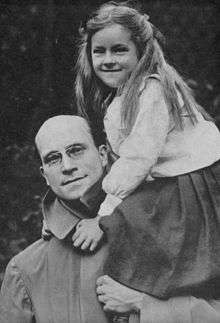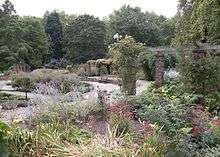Alfred Salter
Alfred Salter (16 June 1873 – 24 August 1945)[1] was a British medical practitioner and Labour Party politician.[2]


Early life
Salter was born in Greenwich in 1873, the son of Walter Hookway Salter and Elizabeth Tester. Following education at John Roan School, Greenwich, he went on to study medicine at Guy's Hospital, London.[2] He qualified in 1896 and in the following year was awarded the Golding-Bird gold medal and scholarship in public health, and the Gull research scholarship in pathology. He was made house physician and resident obstetric physician at Guy's and was appointed as bacteriologist to the Lister Institute of Preventive Medicine.[2]
In 1898 he became a resident at the Methodist Settlement in Bermondsey, an area of south-east London alongside the River Thames, then an area with widespread poverty. The major source of employment in the area during the 20th century until the 1970s was the Port of London. Until the docks were nationalised after World War II, most of the men working in the docks were employed on a contingent daily basis; the casual nature of this work made it difficult to make a decent living, and Bermondsey was an area of great poverty While at the Settlement, which had been established by Rev. John Scott Lidgett, Salter set up mutual health insurance schemes and adult education classes on health matters.[3] In 1900 he married Ada Brown, who shared his political and social views.[2]
In the year of his marriage he established his medical practice in Bermondsey, and the couple worked together in trying to alleviate the effects of poverty in the largely working class area.[3] He chose to offer services free to those who could not pay.[4] This work was to lead the establishment of a pioneering comprehensive health service in the area. (See the background to the formation of the NHS.)
Politics
Salter decided that by entering politics he could effect changes to the squalid environment in Bermondsey far more quickly and profoundly than he could outside the political arena.[3][4] He was elected to Bermondsey Borough Council in 1903, and was also a member of the local board of guardians.[2][4] In March 1906 he was elected to fill a vacancy on the London County Council, representing the seat of Southwark, Bermondsey as a member of the Progressive Party following the election of the sitting councillor, George Cooper, as the area's member of parliament.[5] He was re-elected to the LCC in 1907.[6]
In October 1909 George Cooper MP died. Cooper had been elected as a Liberal Party Member of Parliament (MP), and although Salter had succeeded him on the county council, he had since become aligned with the Independent Labour Party (ILP). On 8 October, Alfred Salter was officially announced as the party's candidate at the by-election.[5] The poll was held on 28 October, and Salter received 1,435 votes, finishing third of the three candidates. Crucially, his intervention probably led to the loss of the seat by the Liberals, with the Conservative candidate John Dumphreys securing a majority of 987 votes.[7]
In March 1910 the triennial election of the London County Council was held. Salter was chosen to defend the Bermondsey seat as a Labour candidate against both the Progressives and the Conservative-backed Municipal Reform Party.[8] He was heavily defeated, coming at the bottom of the poll of five candidates.[9] He contested the same seat in 1913, but was again unsuccessful.[10]
All elections were postponed for the duration of the First World War. When a general election was called in December 1918, the parliamentary constituencies were revised under the Representation of the People Act 1918. Salter was selected as Labour Party candidate for the new Bermondsey West seat, and was described in the following terms by The Times:
"Dr Salter, the Labour candidate, is one of the highly educated idealists who are to be found in the ranks of that party. After a brilliant academic career, he decided to devote himself to work among the poor in Bermondsey, and there he has laboured for many years both as a doctor professionally and as a member of local administrative bodies. Personally, nobody has a word to say against him, but his views are of a very extreme kind. His attitude during the war was that of a pacifist, though he would not, it is said, admit the accuracy of this popular term."[11]
The new constituency was won by the Liberal candidate Harold Glanville, who had been the sitting MP for Bermondsey.
In 1919 municipal elections resumed. In March both Alfred and his wife Ada were Labour Party candidates in the London County Council elections, standing in the neighbouring electoral divisions of Bermondsey West and Rotherhithe. Neither was elected.[12] In November Ada was elected to Bermondsey Borough Council. She held the seat in 1922, and in the same year was elected as the first female mayor of the borough.[13]
Member of Parliament
In the 1922 general election he was again nominated as Labour candidate for Bermondsey West. Salter secured 7,550 votes, a majority of 2,325. He was helped to victory by there being three opposing candidates, with the Anti-labour vote split between Liberal, National Liberal and Independent Unionist opponents.[14] His wife, as mayor of the borough, was the returning officer who declared him elected.[2] A further general election was held in 1923, and Salter lost the seat in a straight fight to the Rev. Roderick Kedward, the Liberal candidate, in spite of increasing his vote to 8,298.[14] Political instability led to another election in October 1924. Salter was able to overturn the result of the previous year, increasing his vote to 11,578 and unseating Kedward with a majority of 2,902.[15] He was re-elected in the general elections of 1929, 1931, and 1935, but stood down at the 1945 election, when he was in very poor health, and died soon afterwards, aged 72.[2]
Personal beliefs
According to Fenner Brockway, the anti-war activist, Salter in his youth was known as the "Settlement firebrand – militant Republican, militant Socialist, militant Agnostic, militant Teetotaller, militant Pacifist."[16] Alfred Salter was a committed Christian and pacifist, a Quaker from 1900 onwards, and later an active member of the Peace Pledge Union. He was one of the founders of the Socialist Medical Association and a friend of its President Somerville Hastings, with whom he made a trip to the Soviet Union in 1931.[17] In 1936 he advocated the creation of a new League of Nations to which the possessions of the British Empire should be transferred.[2] Salter believed appeasement could avert war with Germany, stating in November 1938 that "the average German will withdraw his backing from Hitler if we show willingness to be just".[18] The failure of appeasement and outbreak of World War II left Salter deeply depressed.[18] Despite his constituency being heavily bombed by the Luftwaffe during the Blitz, he opposed the strategic bombing by the Royal Air Force Bomber Command on moral grounds, one of the few Parliamentarians to do so, along with fellow Labour MP Richard Stokes and Bishop George Bell in the House of Lords,
Salter was a strong advocate of Guild Socialism and of associationalism.[3] He was also a strong supporter of the Temperance Movement, i.e. abstaining from alcohol, and caused controversy when he spoke out against widespread drunkenness in the House of Commons.[2] He supported free speech, and resigned from the Bermondsey Borough Labour Party and the local trades council when they organised a counter-demonstration to prevent the British Union of Fascists from holding a march in the borough. (See the 1936 Battle of Cable Street for context.) He accused the trades council of being "Communist in sympathy and Fascist in methods".[2]
Memorials to Alfred and Ada Salter

The Alfred Salter Primary School was opened in 1995 to meet the growing demand for school places in Rotherhithe, due to the redevelopment of the old Surrey Docks.[19] The Ada Salter Garden is in Southwark Park within the Old Surrey Docks area.[20] The Alfred Salter Bridge is a footbridge leading off Watermans Lane, between Stave Hill and Redriff Road, near Greenland Dock as part of the Russia Dock Woodland.[21]
The statue of Dr Salter seated on a bench, shown above, was stolen, presumably for the value of its bronze, in November 2011.[22] The Salter Statues Campaign group raised £60,000, which Southwark Council matched, to pay for replacement statues, and these were unveiled on 30 November 2014.
A Salter Memorial Lecture is promoted by the Quaker Socialist Society each year as a fringe event at the Britain Yearly Meeting of the Religious Society of Friends (Quakers).[23]
References
- Leigh Rayment's Historical List of MPs – Constituencies beginning with "B" (part 2)
- "Obituary". The Times. 25 August 1945. p. 6.
- "Alfred Salter: Health, welfare and socialism". Infed: the encyclopaedia of informal education. Archived from the original on 19 June 2010. Retrieved 7 November 2009.
- "Bermondsey History". Discover Southwark. London Borough of Southwark. Archived from the original on 20 August 2009. Retrieved 7 November 2009.
- "Election Intelligence. Southwark (Bermondsey Division)". The Times. 9 October 1909. p. 10.
- "The London County Council Election, Great Municipal Reform Victory". The Times. 4 March 1907. p. 6.
- "Election Intelligence. Bermondsey, Unionist Gain". The Times. 29 October 1909. p. 8.
- "The London County Council Election. List Of Labour Candidates". The Times. 16 February 1910. p. 6.
- "London County Council Election. An Equality Of Parties". The Times. 7 March 1910. p. 7.
- "London Elections. Victory Of Municipal Reform. An Increased Majority". The Times. 7 March 1913. p. 9.
- "A Confused Situation. Local Men In West Bermondsey". The Times. 10 December 1918. p. 10.
- "L.C.C. Election Results. Public Indifference, Many Labour Successes". The Times. 8 March 1919. p. 14.
- "New Mayors. Four Women Chosen., Elections In London And Country". The Times. 10 November 1922. p. 7.
- "The General Election. First Returns, Polling In The Boroughs, Liberal Gains". The Times. 7 December 1923. p. 6.
- "The General Election. First Returns, Polling In The Boroughs". The Times. 30 October 1924. p. 6.
- Brockway, Fenner (1949) Bermondsey Story: the Life of Alfred Salter. Allen and Unwin. ISBN 0-9526203-0-8. p. 14
- Stewart, John (1995). "Socialist proposals for health reform in inter-war Britain: the case of Somerville Hastings". Medical History. 39 (3): 338–357. doi:10.1017/s0025727300060105. PMC 1037003. PMID 7643673.
- Ceadel, M. (1980) Pacifism in Britain, 1914–1945 : The Defining of a Faith. Oxford : Clarendon Press. ISBN 0198218826. p. 280.
- alfredsalter.com
- "Rotherhithe Circular Walk (5½ miles)". Inner London Ramblers. Archived from the original on 24 April 2012. Retrieved 28 March 2012.
- "Recent News". Russiadockwood.ukfriends.com. Archived from the original on 29 April 2012. Retrieved 28 March 2012.
- "Plea issued for safe return of Salter statue – Southwark Council". Southwark.gov.uk. 2 December 2011. Archived from the original on 27 May 2012. Retrieved 28 March 2012.
- "News Release – Quakers consider human rights, earth and economics". Quakers in Britain. Archived from the original on 23 December 2014. Retrieved 7 July 2012.
External links
| Wikimedia Commons has media related to Alfred Salter. |
- Hansard 1803–2005: contributions in Parliament by Alfred Salter
| Parliament of the United Kingdom | ||
|---|---|---|
| Preceded by Harold James Glanville |
Member of Parliament for Bermondsey West 1922–1923 |
Succeeded by Roderick Kedward |
| Preceded by Roderick Kedward |
Member of Parliament for Bermondsey West 1924–1945 |
Succeeded by Richard Sargood |